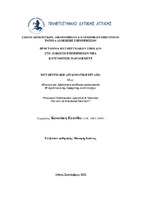Επιλογή και αξιολόγηση απόδοσης προσωπικού: Η περίπτωση της δομημένης συνέντευξης
Personnel performance appraisal & selection: The case of structured interview

Keywords
Δομημένη συνέντευξη ; Επιλογή υποψηφίων ; Αξιολόγηση απόδοσης ; Διαχείριση ανθρώπινου δυναμικού ; Structured interviewAbstract
Η παρούσα εργασία καταπιάνεται με το ζήτημα της δομημένης συνέντευξης, ως πυρήνα του περιεχομένου της, ωστόσο παρουσιάζονται και ορισμένα στοιχεία άλλων μορφών συνεντεύξεων (όπως της μη-δομημένης και της ημι-δομημένης), προς σύγκριση αυτών των χαρακτηριστικών και εξαγωγή χρήσιμων συμπερασμάτων. Η δομημένη συνέντευξη αποδείχθηκε πως δεν αποτελούσε πάντοτε επιδίωξη των οργανισμών τόσο στο δημόσιο όσο όμως και στον ιδιωτικό τομέα και η χρησιμότητά της άρχισε να εκτιμάται περίπου από τις αρχές αυτού του αιώνα, μετατρέποντάς την πλέον σε βασικό εργαλείο αξιολόγησης υποψηφίων.
Από μόνη της η διαδικασία διενέργειας συνεντεύξεων θεωρείται ιδιαίτερη και μπορεί να καταστεί χρονοβόρα αλλά και πολυέξοδη για έναν οργανισμό, ενώ δεν εγγυάται την επιτυχία στην επιλογή του τελικού υποψηφίου ή υποψηφίων. Η δομημένη συνέντευξη όμως φαίνεται πως έχει κερδίσει την εμπιστοσύνη των οργανισμών, αφού μπορεί να προσδώσει σε αυτούς ακόμα και κύρος, στην αντίληψη των υποψηφίων για τον τρόπο με τον οποίο αντιμετωπίζονται καθ’ όλη τη διάρκεια της αξιολόγησής τους.
Συμπερασματικά, η εργασία καταλήγει στο ότι οι δομημένες συνεντεύξεις παρουσιάζουν αυξημένες πιθανότητες αντικειμενικής επιλογής ενός υποψηφίου, αφού δίνουν ιδιαίτερη έμφαση στο γνωστικό του υπόβαθρο, όπως επίσης και στις δεξιότητες που μπορεί να αξιοποιήσει κατά τη διάρκεια της εργασίας του. Επιπλέον, το είδος αυτό επιτρέπει την ελάχιστη δυνατή συναισθηματική επίδραση στην επιλογή ενός ατόμου που πρόκειται να καλύψει κάποια θέση, αφού η μορφή των ερωτήσεων είναι τέτοια που να μην υπεισέρχονται σε προσωπικές λεπτομέρειες, να διατηρείται το τυπικό ύφος μιας συνέντευξης, να επιδιώκεται η προσωπική τοποθέτηση των υποψηφίων σε καίρια ζητήματα ή πιθανά σενάρια κρίσιμων καταστάσεων. Ταυτόχρονα, συνδράμει στην κατανόηση των αξιών που επιθυμεί ο οργανισμός να διατηρούνται στην εσωτερική του λειτουργία και την ομοιομορφία του εργασιακού προφίλ των υπαλλήλων του.
Abstract
The present study deals with the subject of structured interviews, as the core of its content, however, there are also a few more elements presented, concerning other types of interviews (such as the unstructured one and the semi-structured). These elements are used for the comparison between the main characteristics of various forms of interviews, as well as the extraction of useful conclusions. Structured interview has been proved that was not always a pursuit of organizations in both public and private sector, and its usefulness started being appreciated near the beginning of the present century, turning structured interviews into a key candidate evaluation tool. The interview process itself, considered being a special one and could be time-consuming as well as costly for the vast majority of the organizations. Additionally, it does not guarantee the success on selecting the appropriate candidate between these reaching the final stage of a selection process. Structured interview though, seems to have gained the trust of organizations, since it can even offer them some prestige, in the perception of candidates, concerning the way they are treated throughout their evaluation process. In conclusion, the study ends highlighting that, structured interviews show increased chances for an organization to objectively select candidates, since they place a special emphasis on his/her cognitive background, as well as on the skills he/she could make a good use of, during duties completion. Additionally, this type of interviews allows the minimum possible emotional influence on the selection process, when a candidate is going to fill a job position. This happens due to the questions form, which prohibits interviewers to enter in the sensitive circle of personal questions, helps them maintain the typical style of such a process, seeks candidates’ personal positioning on key issues or possible scenarios of critical situations. In the same time, it helps understanding of the values the organization wishes to maintain in its internal operation, as well as on the uniformity of its employees work profile.

